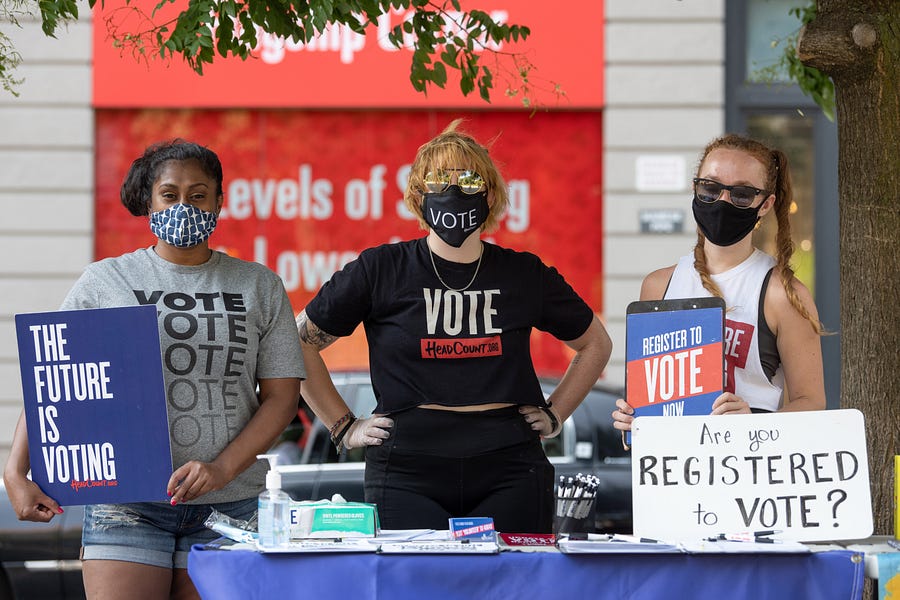In 2020, women set a new record for the number of female major-party candidates running for seats in the House of Representatives, with 583 female candidates filed to date. Joe Biden has tapped Kamala Harris, one of six women to run for the Democratic presidential nomination this year, to run as his vice president. And in the White House, nearly half of President Trump’s staff are now women. As we mark the 100th anniversary of the ratification of the 19th Amendment tomorrow, it’s safe to say that women are now a dominating force in American politics. But it hasn’t been a smooth journey.
It took more than 70 years after Elizabeth Cady Stanton organized the first women’s rights convention before women everywhere could vote in a presidential election. Congress passed the 19th Amendment on June 4, 1919, and it was ratified by the states and ushered into law on August 18, 1920.*
Today, even with record numbers of candidates, women still trailing men when it comes to getting names on the ballot, constituting only 29.1 percent of all U.S. House candidates this year, for example. But when it comes to actually casting their ballots, women continuously surpass their male counterparts in voter turnout.
How did we get here? And what immediate effect did women’s suffrage have on female political participation? Conventional wisdom during the early 20th century held that women voted just like their husbands in the decades following the ratification of the 19th Amendment. Even sophisticated pollsters fell into this trap: “How will [women] vote on election day?” scoffed pollster George Gallup in 1940. “Just as exactly as they were told the night before,” he said, although there’s little empirical basis to support this claim. The Census Bureau did not begin tracking voter turnout until 1964 and exit polling did not become a commonplace practice until the 1960s and 70s, meaning it’s extremely difficult to track female policy preferences in the aftermath of the 19th Amendment’s passage.
What we do know is that geographic location certainly played a major role in whether women made it to the polls. “In 1920 when the 19th Amendment had first been ratified, if you lived in a state that had a lot of election rules like poll taxes and literacy tests, a very, very few percentage of women voted, whereas in other places with lots of competition and no rules, half of women turned out to vote in 1920,” said Christina Wolbrecht, a professor of political science at Notre Dame, during a recent interview with Notre Dame Arts and Letters program. In Virginia, for example—a state known for its history of literacy tests and poll taxes—fewer than 10 percent of women turned out to vote in 1920, whereas more than half of women voted in Missouri and Kentucky that same year. Excessive electoral rules also disproportionately affected black women and other minorities, who did not get access to the franchise until the Voting Rights Act of 1965.
Beyond literacy tests and poll taxes, polling locations also served as barriers to female political participation. “In the 19th century and into the 20th century, voting took place—especially in cities—in places like saloons and bars,” said Susan Ware, the honorary women’s suffrage centennial historian at the Schlesinger Library at the Radcliffe Institute for Advanced Study in an interview with The Dispatch. She said that during this age of machine politics, women did not feel comfortable venturing out on Election Day and thinking to themselves, “I think I’ll go vote at Joe’s Tavern.”
Another reason for low voter turnout among women in the early 20th century can simply be chalked up to the fact that voting is a learned behavior. “It’s not a situation where every woman in America wanted the right to vote and that was paramount in primary for them,” said Debbie Walsh, director of the Center for the American Woman and Politics. In fact, many women actively opposed women’s suffrage, citing concerns over traditional gender roles, motherhood, and even pseudoscience that claimed voting was detrimental to women’s reproductive health. “So when the 19th amendment was passed and women could start voting,” Walsh said, “it took time for them to start to really vote, to learn that behavior, to make policy, to see themselves as political people, to see themselves as voters and having that voice.”
The presidential election of 1964 completely upended this paradigm. That year, 39.2 million women voted compared to 37.5 million men. Because women are a larger proportion of the population than men, though, it was not until the presidential election of 1980 that women surpassed men in terms of the rate of voter turnout. This trend has continued ever since. In 2016 for example, 63.3 percent of women reported voting whereas only 59.3 percent of men did.
That particular gender gap isn’t much. The real gender gap emerges in how women vote. Women have favored Democratic candidates in each of the last seven presidential elections.* The presidential election of 1996 saw a record setting gender gap of percentage of 11 points, with 55 percent of women voting for Bill Clinton and only 44 percent of men. That 11 point margin was matched in 2016, when only 41 percent of women favored Donald Trump compared to 52 percent of men.
The emergence of the gender voting gap can be traced back to the Ronald Reagan era. Although Reagan beat Jimmy Carter and Walter Mondale with women voters by two points in 1980 and 1984, George H.W. Bush only won them by one point in 1988, and Republicans have not won them again since.* As The Atlantic’s Derek Thompson suggests, Reagan’s ultra-conservative stance on abortion and the Equal Rights Amendment may be partially responsible for this trend. While it’s certainly possible that these issues partially explain the emergence of the gender gap, polling suggests that social issues might not be as important as we think.
In the 1970s, AEI public opinion analyst Karlyn Bowman wanted to find out what was driving the emergence of the gender gap. Based on data from 1935-1975, she found that men and women differed on when it was proper for a society to use force, with women being much less enthusiastic about sending troops abroad and more enthusiastic about gun control. She also found that economic issues, education level, and party affiliation are much bigger predictors of voting behavior for women.
According to Pew Research Center’s polling data, women are just as likely to say that the state of the economy is an important factor that influences their vote. “We think that what is largely happening with women voters is that women see themselves as more economically vulnerable than men,” said Debbie Walsh. “They make less money than men do, they have less money saved for retirement, and then they’re more employment insecure than men are,” Debbie Walsh said. In essence, socioeconomic status has translated into party ID. “Women are more likely to worry about preserving a social safety net for people, whereas men are more likely to favor major cuts in terms of the role of the federal government and the provision of social services,” said Susan J. Carroll from Center for the American Woman and Politics.
Women also tend to be lagging indicators in public opinion. “For example if you ask them whether the fundamental nature of the Soviet Union had changed, men were much more likely in ’89-’90 to say, ‘Oh yes it’s a different country,’ “ Bowman said, but “women were not so sure of course.” This trend translates into economic issues as well. “When we were coming out of the 2008-2009 financial crash, it took women a lot longer to believe that the economy was back on track,” Bowman said.
By no means do women constitute a monolithic voting bloc, however. “There was a misconception in 2016 out there that somehow because a woman was running for president, that all women were going to vote for her,” said Debbie Walsh. Hillary Clinton did very well with black women, Latino women, and college educated white women. But the reality is that party affiliation is a key predictor of voting behavior. “At the end of the day, Republicans vote for Republicans,” Walsh said.
Despite this trend, June polls showed Joe Biden leading women voters by a jaw-dropping 25 point margin. It appears the president is trying to save face by placing his bets on a key demographic he thinks he can win: suburban housewives. “The ‘suburban housewife’ will be voting for me,” he tweeted on Wednesday. “They want safety & are thrilled that I ended the long running program where low income housing would invade their neighborhood. Biden would reinstall it, in a bigger form, with Corey Booker in charge!”
Polls indicate that President Trump is even losing ground with white women voters, whom he won by 9 points in 2016. A Washington Post-ABC News poll from late May showed that Trump is now carrying white women without a college degree by only 6 points, an astounding drop from the 27 percentage point lead he carried four years ago. Given these numbers, it’s within the realm of possibility that the 2020 election may very well see the biggest presidential gender voting gap in history.
Photograph by Alexi Rosenfeld/Getty Images.
Correction, August 17, 2020: This article originally misstated the date the 19th amendment was ratified. It became law on August 18, 1920, not August 18, 2020. It also originally stated Ronald Reagan lost the female vote in 1980 and 1984; he indeed won it. We regret the errors.








Please note that we at The Dispatch hold ourselves, our work, and our commenters to a higher standard than other places on the internet. We welcome comments that foster genuine debate or discussion—including comments critical of us or our work—but responses that include ad hominem attacks on fellow Dispatch members or are intended to stoke fear and anger may be moderated.